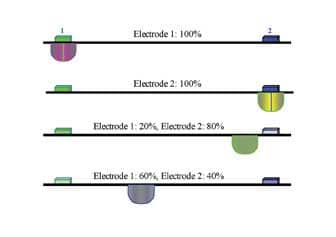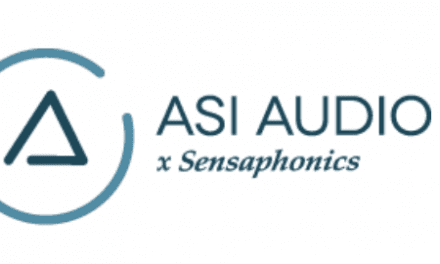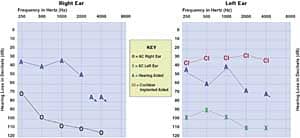With the right combination of education and equipment, people with hearing loss can significantly improve the quality of their communication. But achieving that high quality in the workplace and in other public venues poses a variety of challenges. From computer hums to building reverberations to chatter in a crowd, every location presents unique noise issues that hinder communication. In many cases, assistive listening devices (ALDs) can help individuals with hearing loss overcome these background distractions—even if they already wear a hearing aid.
“Hearing aids offer tremendous benefit, but people with more severe hearing loss often need additional accessories,” says Becky Morris, president of Beyond Hearing Aids Inc, Erlanger, Ky.
A variety of ALDs help users better handle extraneous noise in their workplaces, social venues such as theaters and restaurants, and places of transaction, such as banks and retail stores. Popular solutions include FM systems, personal amplifiers, and even handheld transmitters that give users the portability they need while improving the signal-to-noise ratio. With so many options available, it is important for audiologists to match the technology to their patients’ specific listening needs—and that means being aware of how the products perform in such different venues.
ON THE JOB
When addressing communication demands in the workplace, there is no cookie-cutter solution—it often requires a combination of ALDs and other noise-reduction strategies. “It all comes down to your particular needs and that particular workplace, because every workplace is set up a little differently,” says Lori Foss, marketing director of Harris Communications, Eden Prairie, Minn.
Open workstations and cubicles pose plenty of challenges for individuals with hearing loss. While having a private office space is usually beneficial, cubicle walls can help reduce background noise, and holding meetings in conference rooms rather than open spaces also helps control the signal-to-noise ratio. “One of the best assistive technologies in the world is the one you build,” says Ted Simons, president and CEO of the ELT Group, Nashville, Tenn. Often, the first step is to address environmental concerns, such as avoiding areas with tile, glass, and other reverberant surfaces, when possible.
Telephony is often the most obvious fit for ALDs in the workplace, and Morris notes that today’s phone amplifiers, such as the Clarity inline phone amplifier, can provide up to 40 dB of gain while allowing the users access to all of the features of their office’s phone system—a relatively recent phenomenon. “Another product is the NoizFree cell phone headset, for people who wear hearing aids with telecoils,” she says. “It’s a silhouette that slips between the hearing aid and the head, and when you turn on the telecoil, it provides a strong induction signal.”

|
| Clarity’s CE225 Portable Phone Amplifier. |
Personal amplifiers, such as the Williams Pocketalker, are musts for small-group interactions, such as business lunches and carpools. There are several personal amplifier models out there—some that sell for as little as $15—but Foss cautions that cheaper products often sacrifice quality. “When you try them out, the difference is really clear,” she says. “The Pocketalker has such better sound quality, and it just doesn’t have the handling noise.”
Wireless FM systems, such as the Phonac Microlink, give users the flexibility to maneuver without worrying about cords getting in the way. For meetings and conferences, personal FM systems are popular for their versatility and ease of use. However, they are not ideal for discussing confidential matters. “In those instances, we cannot use radio frequency,” Simons says. “It penetrates walls, and if it penetrates walls, it can be captured.”
To maintain confidentiality, corporate boardrooms and even government buildings such as courthouses are often outfitted with infrared technology that converts sound into light waves that will not be transmitted outside the designated area. Simons notes that just as there are two bands for FM systems (72 to 76 MHz and 216 MHz), there are two infrared bands—the 95-KHz frequency is used primarily for cinemas, live theaters, and churches, while the 2.3-MHz band is more popular in government buildings, where mandated fluorescent lighting can interfere with the lower frequency option.
Of course, not every career path leads into an office building. Professionals such as teachers, physicians, and chefs with a hearing loss need solutions tailored to their unique environments. Morris, whose book On the Job with Hearing Loss (Morgan James Publishing, 2007) includes occupational reports and case studies that explore the communication demands of 17 common professions, says that while FM systems are the most popular solution for the classroom, communicating effectively with students is still a challenge for teachers.
“It’s very difficult because microphone placement is the most important issue, and a single microphone often isn’t good enough,” she says. Teachers may need to supplement ALDs such as FM systems and handheld transmitters by moving around the room to be in closer proximity to the speaker, or by instituting special rules whereby students can speak only when they hold the microphone.
Other professions require job-specific ALDs. For example, Morris says that not being able to hear through a stethoscope could force a physician into early retirement. “Hearing aids typically are programmed for high-frequency gain for speech understanding,” she says. “The stethoscope emits low-frequency heart and valve sounds that aren’t even picked up by the hearing aid.” She adds that improving the interface between hearing aids and stethoscopes would be a major boon for the health care industry.
ABOUT TOWN
Although by law, many venues are required to provide assistive listening technology, such as headsets or even telecoil-compatible solutions, individuals with hearing aids may not be able to use the offered systems.
“Public venues that offer assistive listening systems often do not have accessories that are compatible with hearing aids, and people must remove their hearing aids to hear,” Morris says. “It requires some detective work to find out the type of assistive listening system that is used, and people often purchase their own individual listening option that is compatible with the venue’s system and their own hearing aid.”
Many of the same technologies used in the workplace, such as personal amplifiers, are also effective in public venues such as theaters, banks, and restaurants. The idea with any of these products is to create what Simons calls a “bubble” in which communication can take place despite nearby noise interference.
For example, when dining with a group that included hearing-impaired individuals a few years ago, Simons hooked up several Pocktalkers to induction neck loops and microphones, which made it possible for his party to enjoy one another’s conversation until closing time, despite the noisy, crowded restaurant. “It was interesting, because as a normal hearing person, I actually had to put on equipment to get inside the ‘bubble’ or I couldn’t follow the conversation,” he says.
|
To find past articles on ALDs, search our online archives. |
Both FM systems and infrared systems are common in public venues. Infrared systems are particularly well suited to cineplexes because they can use the same frequency for all of the theaters, in contrast to FM systems that would require a different channel for each auditorium, Simons notes.
There is also a resurgence of interest in loop systems, which generally interface with telecoil when users are inside the “looped” area. While Simons cautions that this technology is vulnerable to electromagnetic interference, he says that it can go a long way toward improving communications in places such as a post office or bank. “One of the most exciting places to use magnetic induction is at any transaction point,” he says.
With a small, self-contained, rechargeable induction loop on the counter, customers can conduct normal transactions without service personnel needing to raise their voices, which could compromise private matters such as bank withdrawals. “The field dissipates at 4 feet away,” Simons says. “So your whole world isn’t being exposed to everybody else. You have privacy.”
Of course, not all hearing aids support telecoil—and far fewer hearing aids incorporate telecoil in North America than in European countries, for example. Simons says appearance plays a role in this, because telecoil is most effective in full-shell hearing aid models, which are not as popular in the United States. “We want to have in-canal hearing aids, [but] the telecoil would be so small that it wouldn’t have enough power to be very effective,” he says.
LOOKING FORWARD
Future ALD developments will likely piggyback onto platforms created in consumer electronics. As digital technology becomes increasingly prevalent, for example, all eyes are on Bluetooth, which is already creeping into the ALD market. “I believe Bluetooth receivers may be built into hearing aids soon,” Morris says. “That’s going to be huge, as Bluetooth becomes more integrated.”
Digital technology offers exciting opportunities for ALD manufacturers. “Between microprocessor control and digital signal processing, there is room for significant improvements,” Simons says. “By using digital signal processing, we could improve dramatically the quality of audio in modern telephony.” Simons is also excited about the implications of using radio-frequency identification (RFID) technology in assistive listening contexts, as well as the implications for digital infrared systems, which could give every theatergoer a personal surround-sound experience, for example.
In the meantime, audiologists can play a vital role in educating patients about ALD options. Having a few products in the office for patients to try, or even just providing them with some literature, can help address their whole hearing health. For patients who do not need a hearing aid right away, learning about these devices from an audiologist can also keep that relationship open so that they know where to go when they decide to take that step.
“It shows them that the audiologist is looking at all of their concerns and needs,” Foss says. “People may not be willing to buy a hearing aid right away, but maybe they’d start thinking about it if they had a product that helped them with their hearing.”
Ann H. Carlson is a contributing writer for Hearing Products Report. For more information, contact [email protected]





